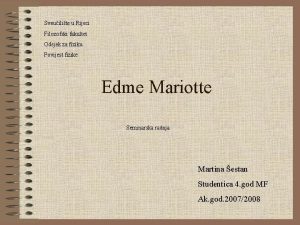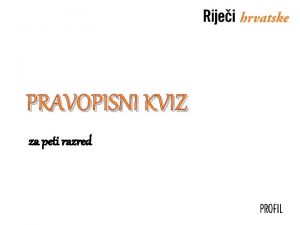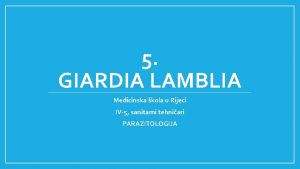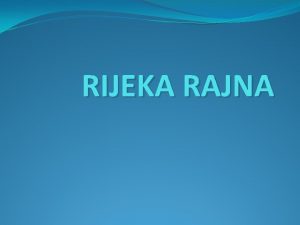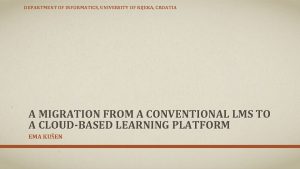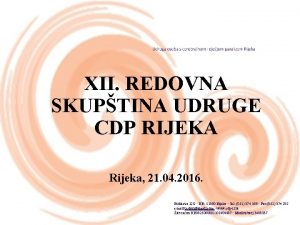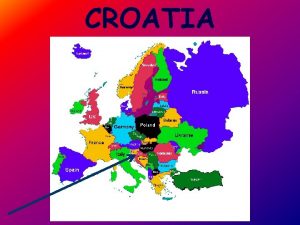Department of Informatics University of Rijeka Radmile Mateji

















- Slides: 17

Department of Informatics, University of Rijeka Radmile Matejčić 2, 51000 Rijeka, Croatia http: //www. inf. uniri. hr Data Warehouse design models in higher education courses Patrizia Poščić, Associate Professor patrizia@inf. uniri. hr Danijela Subotić, Teaching Assistant dsubotic@inf. uniri. hr

Overview • Introduction • DW architecture • Modeling practices – Entity-relationship model – Data Vault model – Dimensional model • Conclusion 2

Introduction • Selected Topics in Databases • Graduate study, 1 st year • Data warehouse (DW) design as a topic • Integrating several data modeling practices for complete DW design • Practical assignment at the end of the semester 3

DW architecture 4

Modeling practices • Modeling of existing database (DB) sources – Entity-relationship model – Relational model • Modeling enterprise data warehouse (EDW) as system of records – Data Vault model • Modeling data marts (DM) – Dimensional model 5

Business case • We use a business case which deals with a DW for the outdoor and adventure equipment sales company • All data model examples (which are shown on following slides) are made in Erwin 9. 5 and are based on IDEF 1 X 6

Entity-Relationship (ER) model Sales DB Marketing DB 7

Data Vault model • A data modeling method that supports design of data warehouses for long-term storage of historical data collected from various data sources • Based on the assumption that the DW environment is in constant change • It highlights the need for tracking the origin of data contained in the database, through empirically defined set of metadata • Enables tracking the value back to the source and tracking the history of changes 8

Data Vault model • There is no difference between good and bad data - all the data is stored at all times, regardless of whether they are adaptable to business rules - avoiding the loss of information • The structural data are explicitly separated from descriptive attributes, regardless of whether they come from the same source • Model flexible to changes in business environment • Allows for a gap analysis and trend projections 9

Data Vault model • Any change is implemented in the model as an independent extension of the existing model: – the changes do not affect current applications – all versions of the application can be based on the same, developing DB – all versions of the model are a subset of the DV model • Enables fast parallel loading which reduces the overall costs • Aiming at flexibility and performance 10

Data Vault model • Hub • Link • Satellite 11

Data Vault model 12

Data Vault model (main advantages) • Inserts, deletes, or updates of rows are implemented only as additions (nothing ever get lost/overwritten) • Structural changes of and in data sources results in model expansion, principally by new links and without structural reconstruction of existing DW elements (architectural stability) • Enables rapid parallel data loads 13

Dimensional model • Practically universally used for DM design presentation • Distinguished by star schema design – centralized fact table, which contains a multi-layered keys and one or more numerical business measures – fact (set of measurement) needs to be tracked for a lowest granularity of data – fact is surrounded with a rich context of dimensions – dimension tables are denormalized, they have a simple key and they store business attributes in the form of textual information 14

Dimensional model 15

Conclusion • We presented a set of complementary data warehouse design models which may enable well integrated DW solutions for relational DB implementations • Models based on a common notation (IDEF 1 X) and in a single design tool (Er. Win) • Our goal is to present students with a compact set of modelling knowledge in the field of DB and DW • Upgrade and further develop theoretical knowledge and practical modelling skills through the educational process 16

Thank You for your attention!
 Polyu surveying
Polyu surveying Belarusian university of informatics and radioelectronics
Belarusian university of informatics and radioelectronics George mason university health administration
George mason university health administration Geografske karte prema sadržaju
Geografske karte prema sadržaju Vjetar uvećanica
Vjetar uvećanica Fakultet za fiziku rijeka
Fakultet za fiziku rijeka Delta nila slike
Delta nila slike Pravopisni znakovi 5 razred
Pravopisni znakovi 5 razred Najprometnija europska rijeka
Najprometnija europska rijeka Vrste tla u nizinskoj hrvatskoj
Vrste tla u nizinskoj hrvatskoj Komparativ od vrijedan
Komparativ od vrijedan Rijeka population
Rijeka population Giardijaza
Giardijaza Kojim slivovima pripadaju rijeke hrvatske
Kojim slivovima pripadaju rijeke hrvatske Astrahan rijeka
Astrahan rijeka Najveća europska rijeka
Najveća europska rijeka Mrav sukosan
Mrav sukosan Crnomorski slijev
Crnomorski slijev





